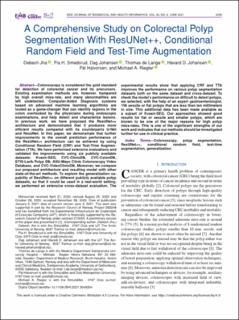| dc.contributor.author | Jha, Debesh | |
| dc.contributor.author | Smedsrud, Pia | |
| dc.contributor.author | Johansen, Dag | |
| dc.contributor.author | de Lange, Thomas | |
| dc.contributor.author | Johansen, Håvard D. | |
| dc.contributor.author | Halvorsen, Pål | |
| dc.contributor.author | Riegler, Michael Alexander | |
| dc.date.accessioned | 2021-01-14T09:28:55Z | |
| dc.date.accessioned | 2021-02-25T10:13:05Z | |
| dc.date.available | 2021-01-14T09:28:55Z | |
| dc.date.available | 2021-02-25T10:13:05Z | |
| dc.date.issued | 2021-01-05 | |
| dc.identifier.citation | Jha, Smedsrud, Johansen, de Lange, Johansen, Halvorsen, Riegler. A Comprehensive Study on Colorectal Polyp Segmentation with ResUNet++, Conditional Random Field and Test-Time Augmentation. IEEE journal of biomedical and health informatics. 2021 | en |
| dc.identifier.issn | 2168-2194 | |
| dc.identifier.issn | 2168-2208 | |
| dc.identifier.uri | https://hdl.handle.net/10642/9734 | |
| dc.description.abstract | Colonoscopy is considered the gold standard for detection of colorectal cancer and its precursors. Existing examination methods are, however, hampered by high overall miss-rate, and many abnormalities are left undetected. Computer-Aided Diagnosis systems based on advanced machine learning algorithms are touted as a game-changer that can identify regions in the colon overlooked by the physicians during endoscopic examinations, and help detect and characterize lesions. In previous work, we have proposed the ResUNet++ architecture and demonstrated that it produces more efficient results compared with its counterparts U-Net and ResUNet. In this paper, we demonstrate that further improvements to the overall prediction performance of the ResUNet++ architecture can be achieved by using CRF and TTA. We have performed extensive evaluations and validated the improvements using six publicly available datasets: Kvasir-SEG, CVC-ClinicDB, CVC-ColonDB, ETIS-Larib Polyp DB, ASU-Mayo Clinic Colonoscopy Video Database, and CVC-VideoClinicDB. Moreover, we compare our proposed architecture and resulting model with other State-of-the-art methods. To explore the generalization capability of ResUNet++ on different publicly available polyp datasets, so that it could be used in a real-world setting, we performed an extensive cross-dataset evaluation. The experimental results show that applying CRF and TTA improves the performance on various polyp segmentation datasets both on the same dataset and cross-dataset. To check the model's performance on difficult to detect polyps, we selected, with the help of an expert gastroenterologist, 196 sessile or flat polyps that are less than ten millimeters in size. This additional data has been made available as a subset of Kvasir-SEG. Our approaches showed good results for flat or sessile and smaller polyps, which are known to be one of the major reasons for high polyp miss-rates. This is one of the significant strengths of our work and indicates that our methods should be investigated further for use in clinical practice. | en |
| dc.description.sponsorship | This work is funded in part by Research Council of Norway project number 263248. Experiments are performed on the Experimental Infrastructure for Exploration of Exascale Com- puting (eX3), supported by the Research Council of Norway under contract 270053. | en |
| dc.language.iso | en | en |
| dc.publisher | Institute of Electrical and Electronics Engineers | en |
| dc.relation.ispartofseries | IEEE journal of biomedical and health informatics; Volume: 25, Issue: 6, June 2021 | |
| dc.rights | Creative Commons Attribution 4.0 International (CC BY 4.0) | en |
| dc.rights.uri | https://creativecommons.org/licenses/by/4.0/ | |
| dc.subject | Colonoscopy | en |
| dc.subject | Polyp segmentations | en |
| dc.subject | ResUNet++ | en |
| dc.subject | Conditional random fields | en |
| dc.subject | Test time augmentation | en |
| dc.subject | Generalizations | en |
| dc.title | A Comprehensive Study on Colorectal Polyp Segmentation with ResUNet++, Conditional Random Field and Test-Time Augmentation | en |
| dc.type | Journal article | en |
| dc.type | Peer reviewed | en |
| dc.date.updated | 2021-01-14T09:28:55Z | |
| dc.description.version | publishedVersion | en |
| dc.identifier.doi | http://doi.org/10.1109/JBHI.2021.3049304 | |
| dc.identifier.cristin | 1871151 | |
| dc.source.journal | IEEE journal of biomedical and health informatics | |
| dc.relation.projectID | Norges forskningsråd: 263248 | |
| dc.relation.projectID | Norges forskningsråd: 270053 | |

